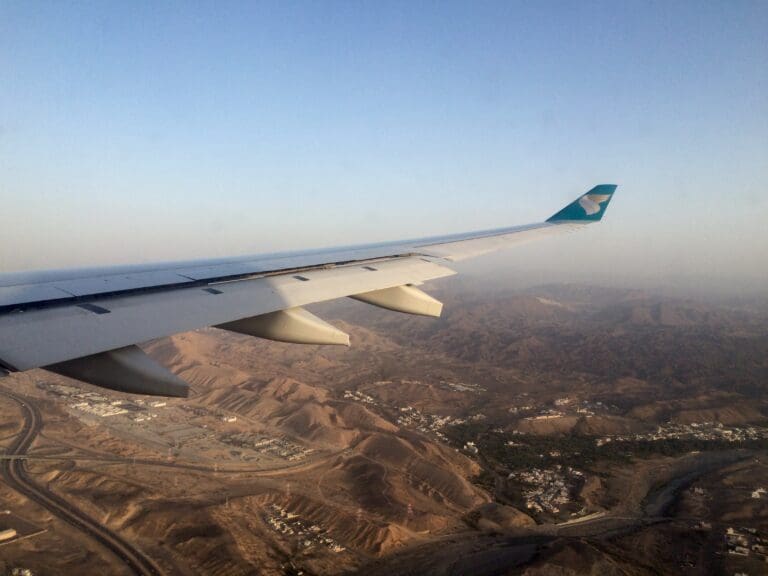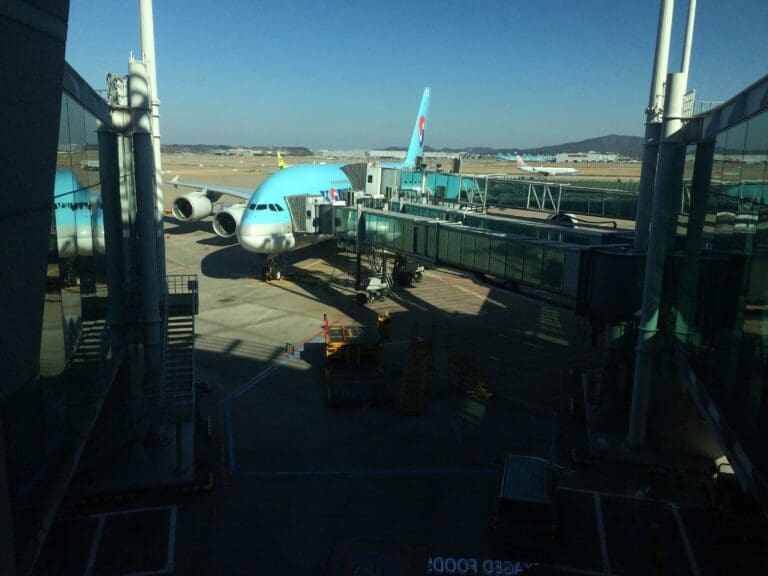Remembering Korean Air’s Boeing 747-400s – a Throwback Review: Jeju to Seoul Gimpo

Background
Once upon a time, catching a Korean Air Boeing 747-400 was not an overly difficult task, as for much of the year, these large jets were deployed on the world’s busiest air route, connecting Seoul Gimpo with Jeju. This meant that sampling a ride on these jets could be done easily and cheaply. Needing to fly back to Seoul after a holiday in Jeju in July 2017, it was only natural that I sought to work one of Korean Air’s Boeing 747-400s into my itinerary. By this time, Korean Air’s Boeing 747-400 fleet was already on its way out and playing a much smaller role than it once did. With the entry-into-service of Korean Air’s Boeing 747-8s, many of these had already found new homes across the world, such as with Nigeria’s Max Air, alongside Atlas Air and Kalitta Air in the US. In the end, Korean Air’s last remaining passenger Boeing 747-400s were withdrawn from use in early 2020, and since then it has been impossible to fly the Jumbo Jet on a Korean domestic service.
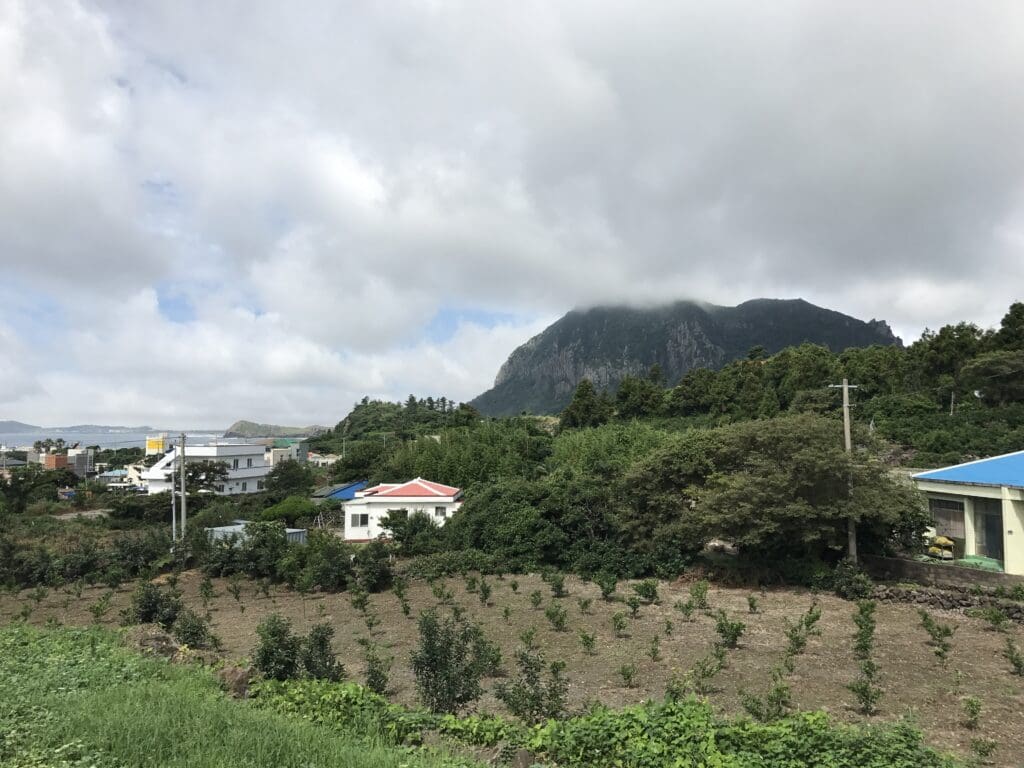
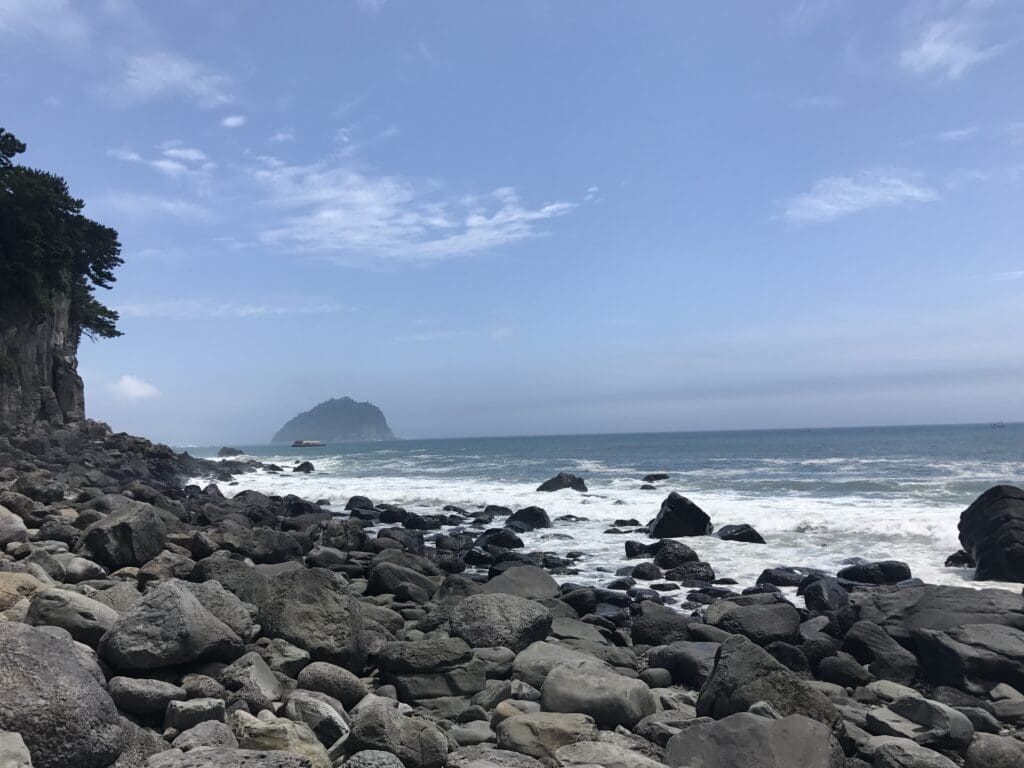
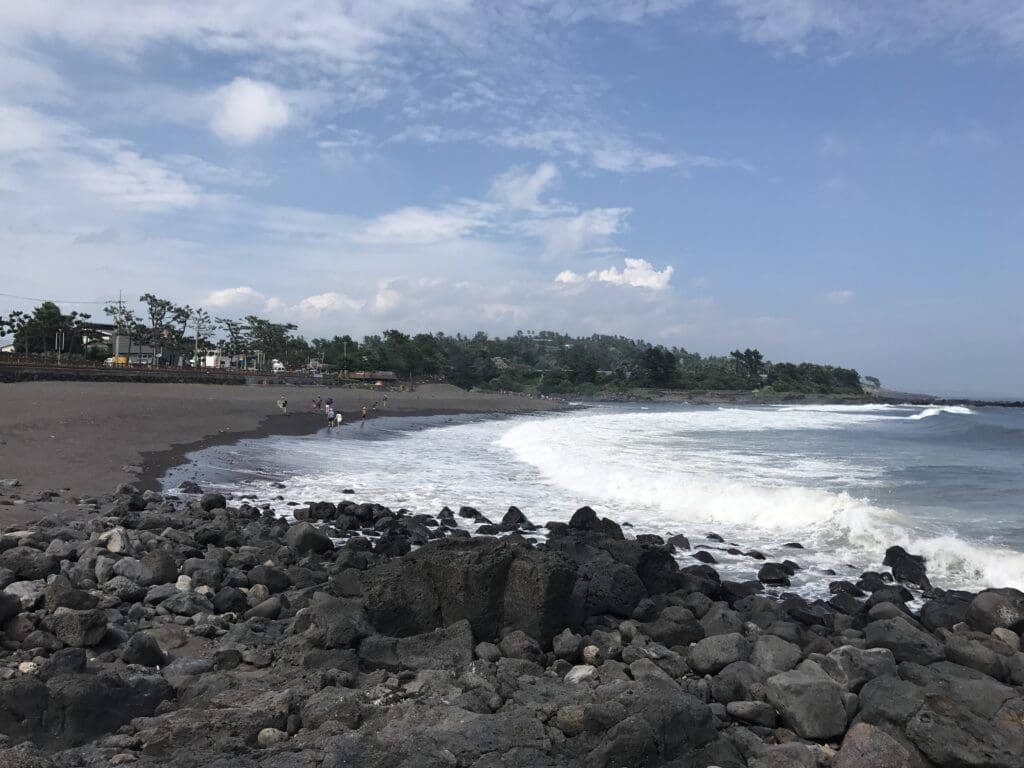

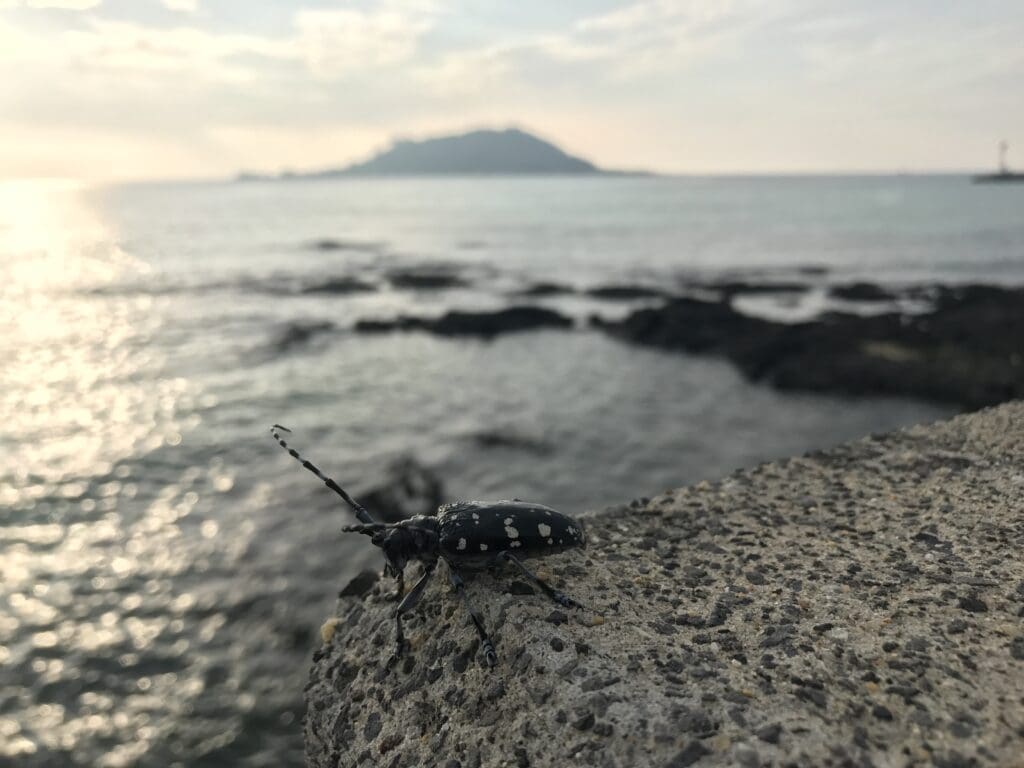


The Trip
It was a typically calm early July morning in a fishing village near Aewol on Jeju’s northern shore. The only occasional break from the peace came from metal birds roaring off to destinations across the mainland and occasionally to airports a little further away in China. At the small harbour, fishing boats of various sizes gently bobbed up and down, devoid of sailors having returned from overnight trips earlier that morning. In the background lay the green slopes of Mount Halla, Korea’s tallest mountain. Heading up the mountain, this green transformed into white clouds that had been simmering around the summit for the duration of my stay in Jeju. Back in the village, small crabs and beetles scurried away from me as I headed up to the main road to catch a taxi to the airport. Whilst I was less than 300 miles away from Korea’s endlessly busy capital, Seoul, I felt a world away.
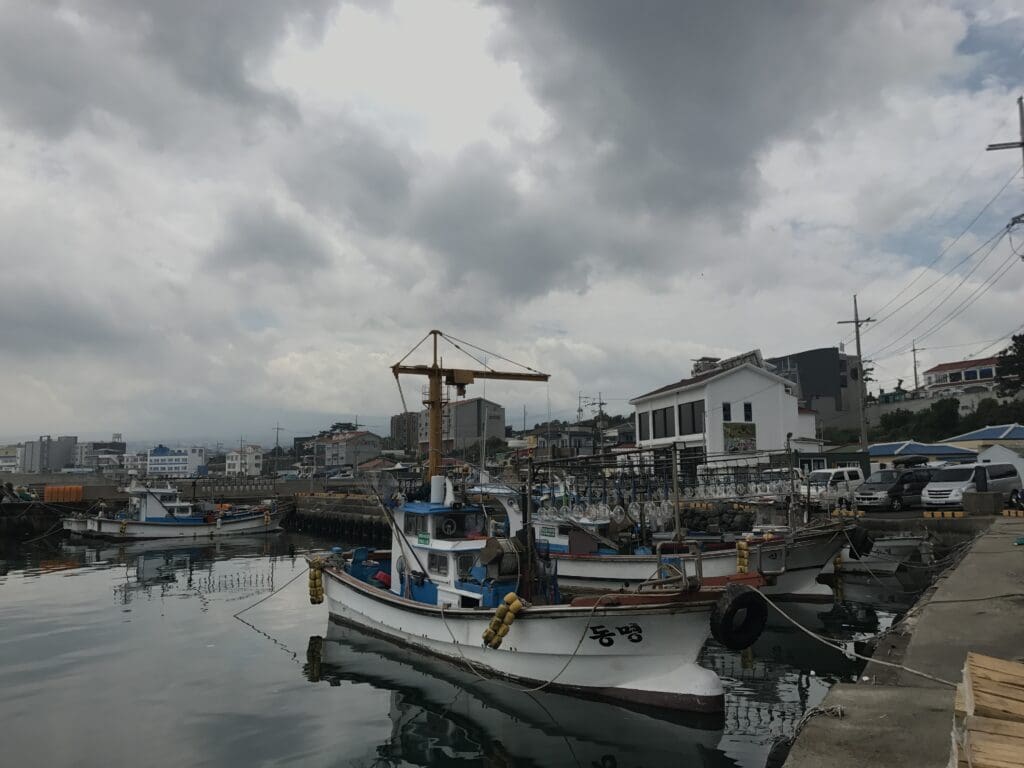
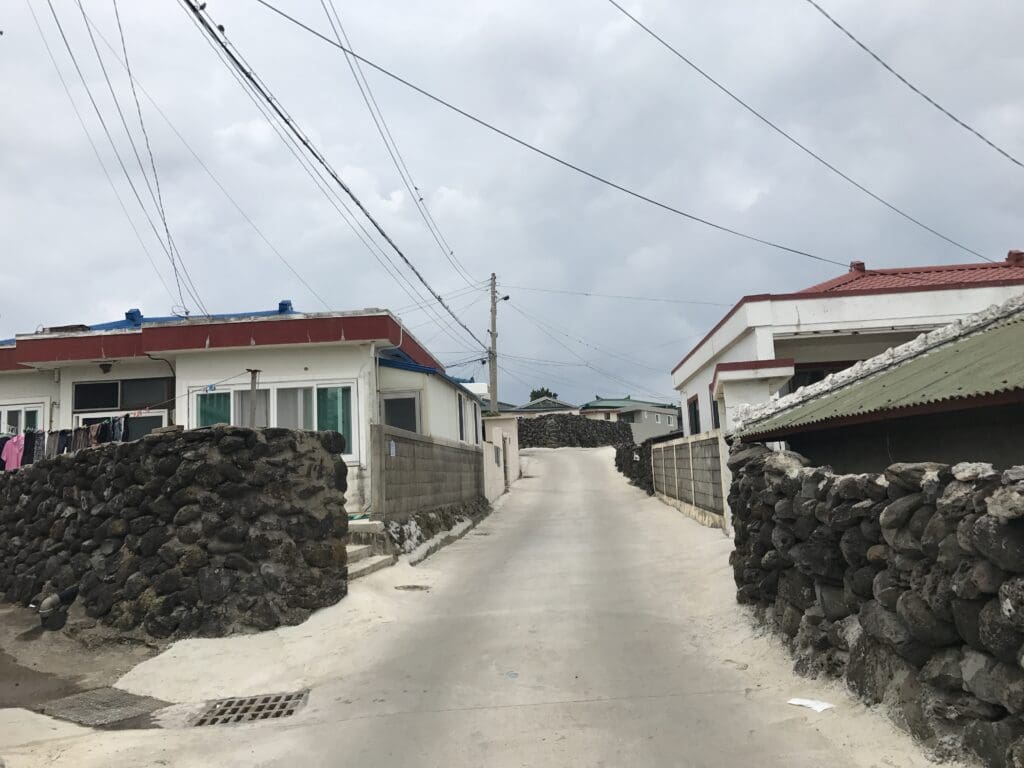
During my five-day trip to Jeju, I had spent two nights on the island’s south coast near Seogwipo and two near Aewol on the north coast. However, as much as I would have loved to stay, it was time to return to Seoul. With July and Korea’s horribly humid summer weather having well and truly arrived, by the time I reached the main road I was roasting and eager for a taxi to appear. However, with my chances of being able to hail a taxi there being slim, I instead ordered a ride using the Kakao Taxi app and waited outside a reasonably sized hotel near the main road with the idea that this would be much easier for the driver to find than the backstreet village hotel where I had been staying. After fifteen minutes of waiting, the modern Hyundai taxi finally disappeared and I was lightheartedly berated by the driver for my choice of taxi app, claiming that this did not work well in Jeju.
From Aewol, the taxi sped along several country roads although once we reached the main road, our progress stalled a little as we seemed to come to a halt at every single red traffic light. Passing the time, the driver made some small talk whilst his impressive megamix of K-pop hits from the 1990s loudly rang out in the background. Around twenty minutes after beginning the drive, Jeju International Airport’s reasonably large terminal appeared and we came to a halt just outside one of the entrances to the check-in hall. That morning, the total journey cost a very reasonable 12,000 won which I paid by card before thanking the driver, collecting my luggage from the boot and making my way into the pleasantly air-conditioned terminal building.

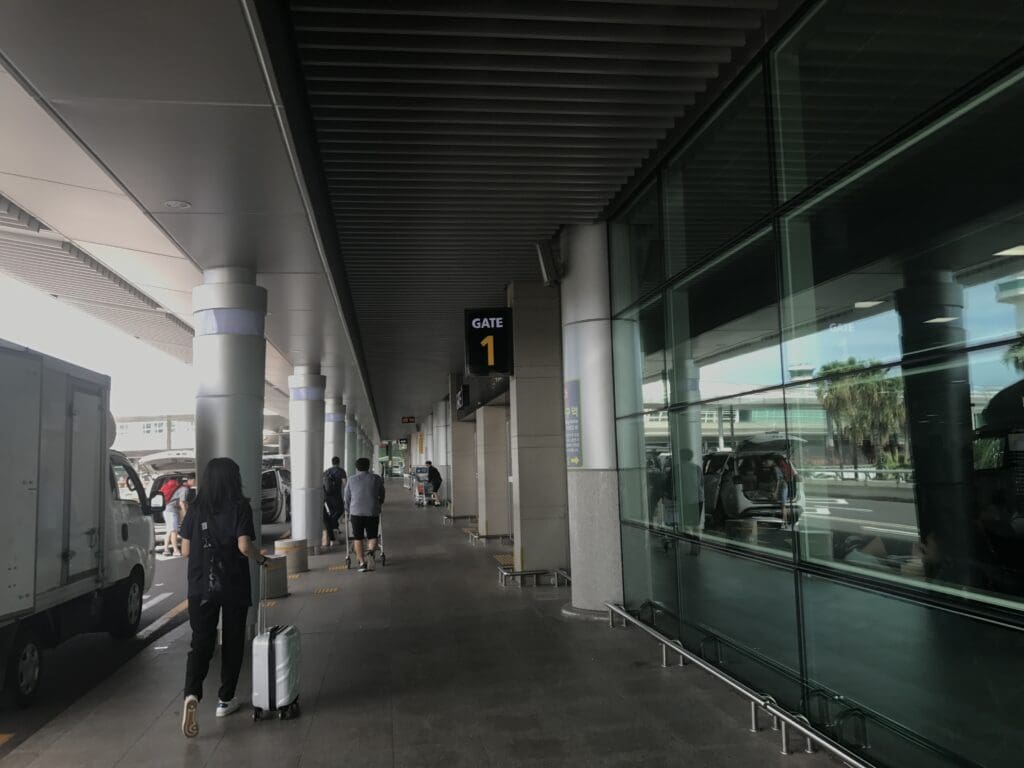
Regardless of whether it is spring, summer, autumn or winter, I have found Jeju International Airport to be eternally busy and that day was no exception. Once inside the check-in hall a mixture of couples, groups of both elderly travellers and school students, solo travellers and everyone in between scurrying about, some shuttling large suitcases to the check-in desks and others speeding towards security. In terms of its layout, the terminal is split into a domestic and international section, and at the former, each carrier enjoys its own well-branded check-in area, from major players such as Asiana Airlines and Korean Air, to minuscule carrier Korea Express Air who operate an Embraer 145 to Yangyang Airport in Gangwon Province. Throughout this, Korea Airport Corporation self check-in machines can be found, which could be used by those departing on all domestic flights. In addition to this, several cafés, convenience stores and restaurants can be found throughout the landside area. Whilst not the fanciest terminal in terms of its design, this is modern enough and despite the high number of passengers, I always find this to be in a clean and reasonable state.
Seeing as I had checked in online and received my boarding pass via the Korean messaging app, KakaoTalk, with no bags to drop off, I was able to head straight to security. In what is a unique arrangement at all Korean domestic terminals, non-Koreans must enter the security area via a separate checkpoint. The reason for this is that several nationalities, most notably Chinese passport holders, can enter Jeju without a visa, but cannot enter the mainland without one. Therefore, an immigration checkpoint is in place to prevent passengers who need a visa to visit the mainland but lacking in one, from leaving Jeju. Following a short queue, I reached the counter where my Korean identity card was checked before I was able to continue onwards to the main security checkpoint. There, as is usually the case in Jeju, nothing more than a very short wait was in order before I reached a checkpoint and following a quick and easy check, I was free to explore the delights of the airside portion of the terminal.
Once through security passengers emerge onto an area that provides the best views of the action outside anywhere in the airside portion of the terminal. In fact, it is worth noting that sadly, thanks to the terminal’s layout, totally unobstructed views of the world outside are limited to this post-security area. Thus, once through security I decided to linger around there for a while and watched as a stream of airliners came and went. Outside the usual plethora of narrow and widebodies from most Korean carriers could be seen, with these taking the form of aircraft from Air Busan, Asiana Airlines, Eastar Jet, Jeju Air, Jin Air, Korean Air and T’way Air. Meanwhile, at the international portion of the terminal, a Tigerair Taiwan Airbus A320 could be seen readying for its return journey south to Taipei. As soon as this departed, a fellow Airbus A320 belonging to Chinese low cost carrier Spring Airlines replaced this. operating a rotation from Shanghai Pudong.



Like many regional airports in Korea, Jeju International Airport also hosts a squadron of military aircraft, and in Jeju’s case, this takes the form of a flight of vintage Lockheed P-3 Orions operated by the Republic of Korea Navy, however, in all the times that I have passed through the airport I have rarely seen these move! That morning, I also spotted a Busan-based Republic of Korea Air Force Lockheed C-130 Hercules making a smoky departure before heading out over the sea.
Once I had spotted myself silly, I headed down the escalator and entered the main portion of the terminal. Admittedly, this is slightly dated in its aesthetic yet it is clean, functional and does a good job at processing the many passengers that pass through this every year. However, I would not say that this is a particularly pleasant place to wait for hours on end and I wouldn’t recommend non-enthusiasts rocking up with hours and hours to go before departure. This hosts a reasonable number of cafés, eateries and shops, however, many of these seemed to feature long queues that morning and given the high number of passengers, there seemed to be relatively few available seats in the main waiting area.
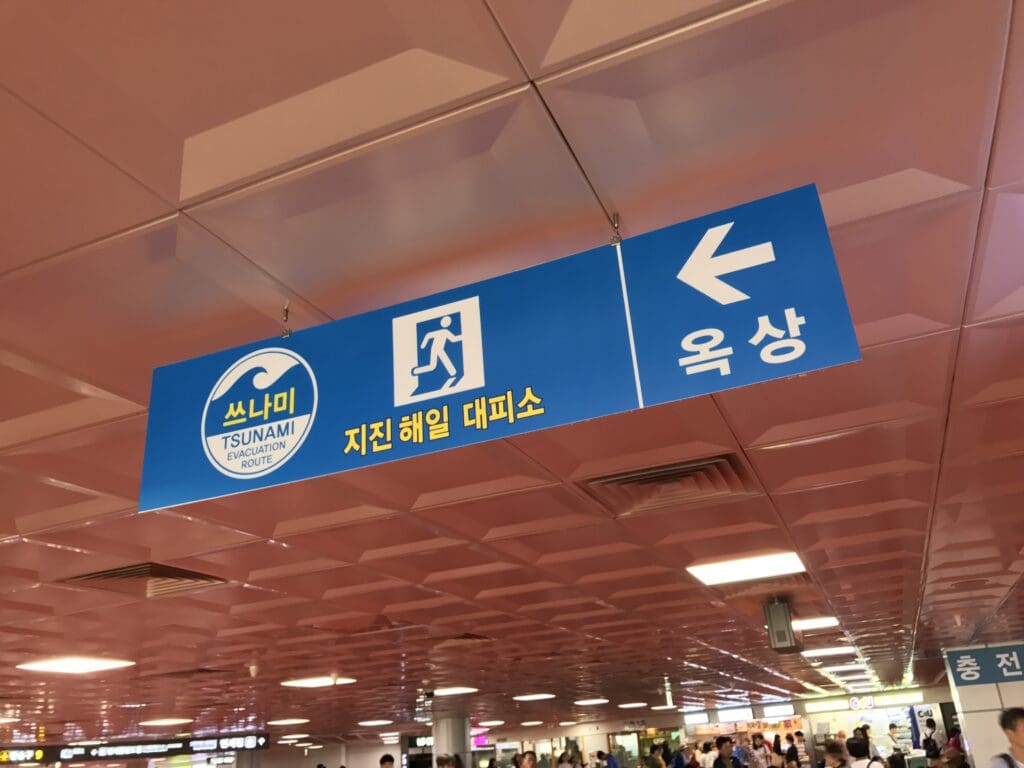


At 1017, the massive Korean Air Boeing 747-400 that would be taking me to Seoul touched down on the island before making a slow and cautious taxi over to Gate 13. Examining the Jumbo Jet’s exterior, this had seen better days as Korean Air’s iconic sky blue paint had faded, contrasting with the fresh-looking nose cone, which had presumably been recently replaced. Meanwhile, significant jetway dirt could be seen around the L2 door along with other marks across the fuselage. A short while later, this aircraft was joined by a second Boeing 747-400, highlighting just how easy it was to catch a ride on a Boeing 747 in Korea in 2017! At that time, Korean Air’s passenger Boeing 747-400 fleet consisted of four aircraft – two of which were based at Seoul Incheon and operated international services and two at Seoul Gimpo which operated exclusively to Jeju.


That morning, I would have the pleasure of flying onboard Boeing 747-4B5, HL7460. Assembled at Everett with the line number 1107, this jet took to the skies for the first time in March 1997, making it around 20.5 years old at the time of my flight. Following testing, this was handed over to Korean Air and has since been deployed on short, medium and long haul routes to destinations across the world, once serving as the airline’s flagship type. In the week before my flight, this particular aircraft had undertaken 42 flights covering almost 11,800 miles between Gimpo and Jeju. Earlier that year the aircraft had been based in Seoul Incheon from where it had operated to the likes of Hong Kong and Taipei, alongside making the odd long haul flight to Frankfurt, Honolulu and Seoul Incheon. This aircraft had suffered from one notable incident during its life with Korean Air which had occurred in January 2016. Specifically, upon landing at Jeju, the engine cowl of the number 4 engine hit a snow pile causing major damage to the engine, wing and flaps. That day, this would be my second time flying onboard HL7460 having had the pleasure of flying in the nose of the aircraft in the small and old-fashioned First Class section between Gimpo and Jeju in November 2016.
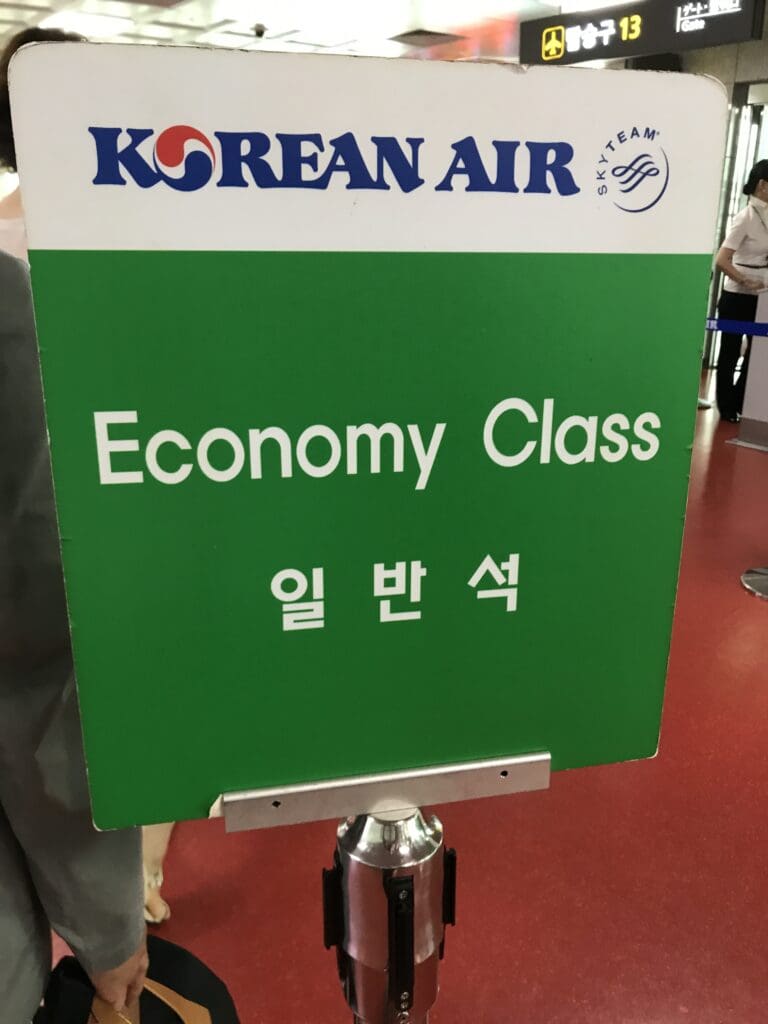
Inside the terminal, by the time our scheduled boarding time of 1050 rolled around, a snaking line of passengers bound for Seoul could be seen leading up to the gate podium. As expected, the majority of passengers appeared to take the form of Korean holidaymakers returning home after a trip to Jeju, however, I also spotted a fair number of suited business people, alongside a couple of groups of Chinese tourists. Once I had joined the queue, I shuffled along and after a few minutes, my mobile boarding pass was scanned and I was free to head down the glass jetbridge towards the Boeing’s L1 door. As is usually the case when flying with Korean Air, a selection of Korean newspapers, both in Korean and English, had been placed on a trolley for passengers to take during boarding.
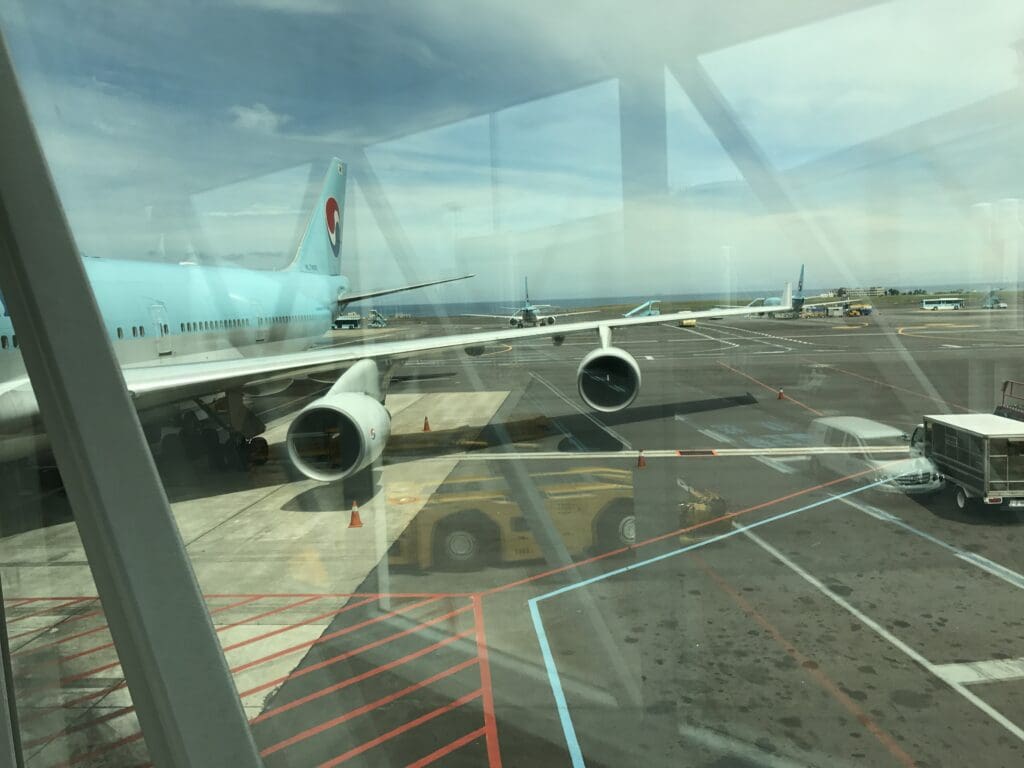

Following a short wait, I stepped into the galley that separates First Class from Prestige Class where I was given a polite greeting in English by one of the two flight attendants standing there welcoming passengers and checking their boarding passes. Once my boarding pass had been checked, I was advised to head down the second aisle and soon entered one of the two Prestige Class cabins onboard, the other being located on the top deck. Those more used to travelling in the luxurious surrounds of premium cabins may have complained about the Prestige Class cabin onboard, with this fitted with Korean Air’s older and privacy-lacking BE Aerospace Minipod seats, each of which was covered in a turquoise fabric cover and came complete with a pillow. Nevertheless, this was still a little fancier than the recliner seats onboard Korean Air’s narrowbody jets, and given the length of the flight, I am sure that few would complain about this.


Continuing down the aircraft, I passed through another large galley where I received another polite greeting before I arrived in the forward Economy cabin. Onboard, Korean Air’s Jumbo Jets feature the Boeing 747-standard 3-4-3 configuration, with each seat covered in either a dark blue or dark brown fabric that is adorned by a repeating pattern. These were a little dated in their design, being a little chunkier than usual, and complete with a slightly retro inflight entertainment screen. Other than this, the seats featured a universal power outlet, a pull-out inflight entertainment remote control, a tray table, a cup holder and a seatback pocket. The latter contained a disease risk area map, Korean Air’s bilingual Korean-English language Morning Calm inflight magazine, the Beyond entertainment guide, a SkyShop catalogue and of course a safety card and sickbag.


Making my way down the cabin, I continued to receive greetings from each crew member I passed before I made it to my seat near the front of the rear Economy cabin. Once I had stowed my bag in the overhead compartments, I slid into my seat and settled in for the ride ahead. Overall, these left me rather impressed, being both soft and comfortable, and featuring a superb amount of legroom that would have proven to be more than sufficient on one of Korean Air’s longest flights! In addition to this, the cabin seemed to be spotlessly clean and I was able to spot almost no signs of any wear and tear as I examined the area around this.

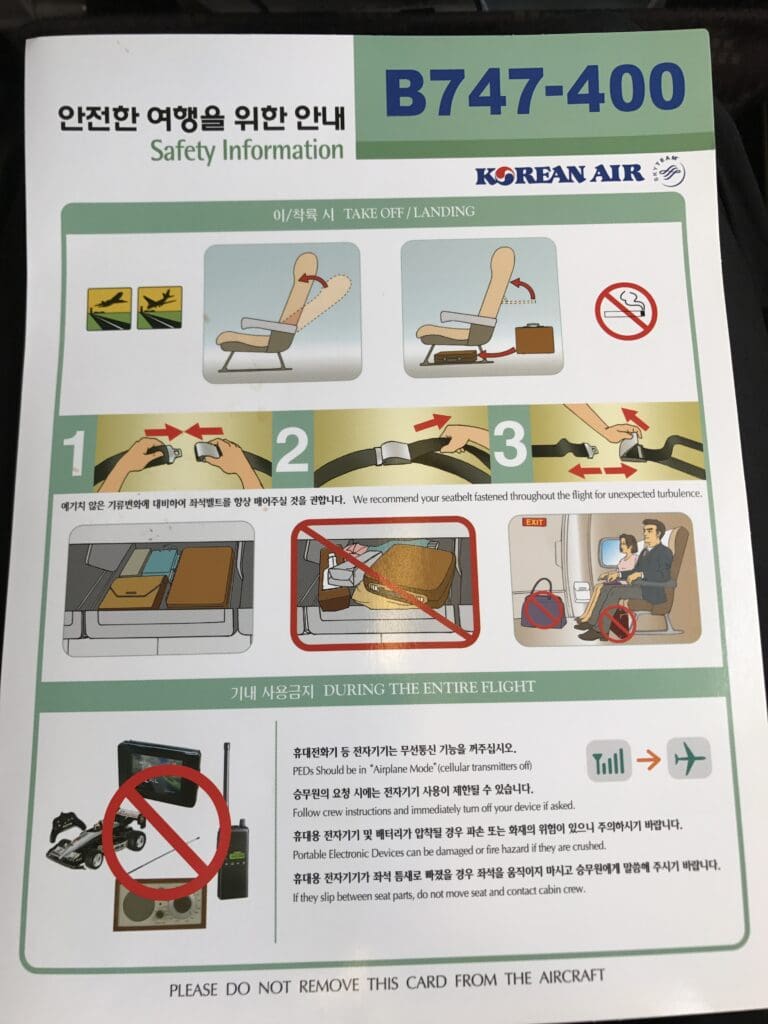


As passengers boarded the aircraft, rather than the usual classical music that accompanies boarding on Korean Air, a more light-hearted selection of songs was being played over the cabin speakers. Around twenty minutes after this had been called in the terminal, it appeared as if all were onboard, and, looking around, it seemed that the flight was almost entirely full. At this time, just below my seat, the last of the containers could be heard and felt being fed into the cargo hold below before an electrical whine rang out as the door was closed and the crew retreated from the aircraft and removed the cones from around the wing.
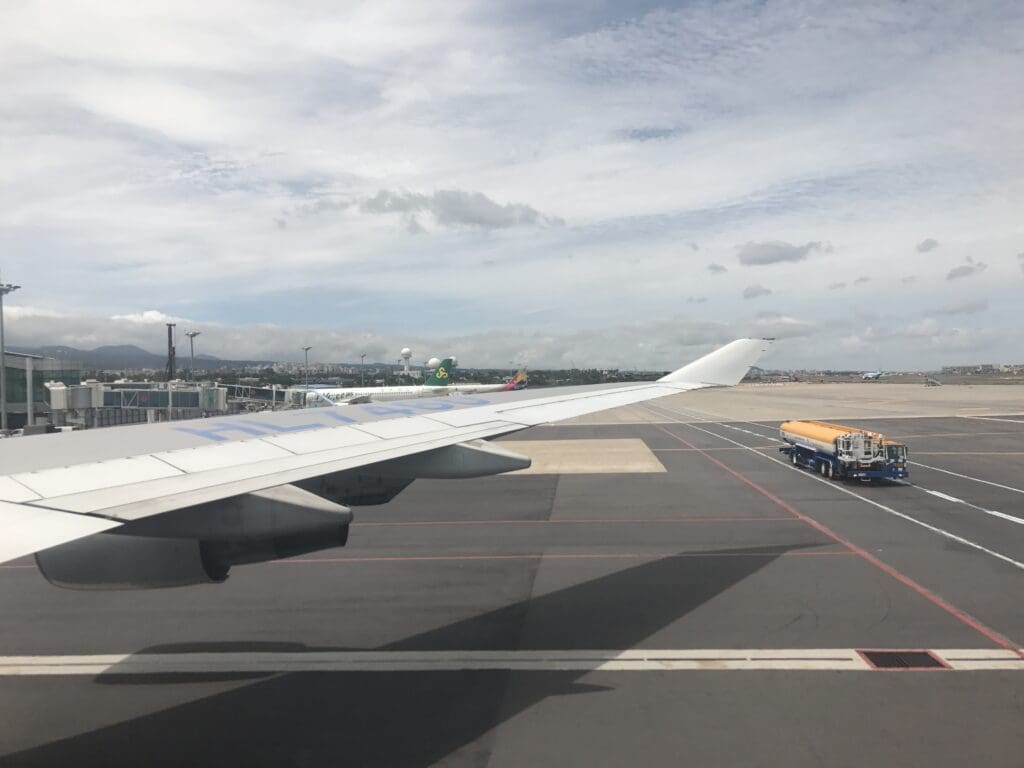
Once the ‘boarding complete’ announcement had been made, the Purser undertook their welcome announcement in Korean and English which featured all the usual information about the flight, warnings regarding bad behaviour, smoking and seatbelts and a word of thanks for flying with Korean Air. Moments after this had been made, the Korean Air logo disappeared from each seatback screen and was replaced by Korean Air’s dated safety video which I believe dates from the early 2000s. Upon coming to an end, the cabin crew took to the aisles and took their time to ensure that absolutely everything was secure and in place for our departure.
Indicating that we would be subject to a slight delay, once all the preparations inside the cabin had been completed, there was no movement. Perhaps providing some explanation, behind us, aircraft were now departing and arriving in the opposite direction. Eventually, eleven minutes after we had been scheduled to depart, at 1121 the Boeing jolted backwards and our pushback commenced. Whilst this was underway, one by one the aircraft’s Pratt and Whitney PW4056 engines powered into life, causing a fair amount of humming and vibrations before the flaps were partially extended with a loud whine.
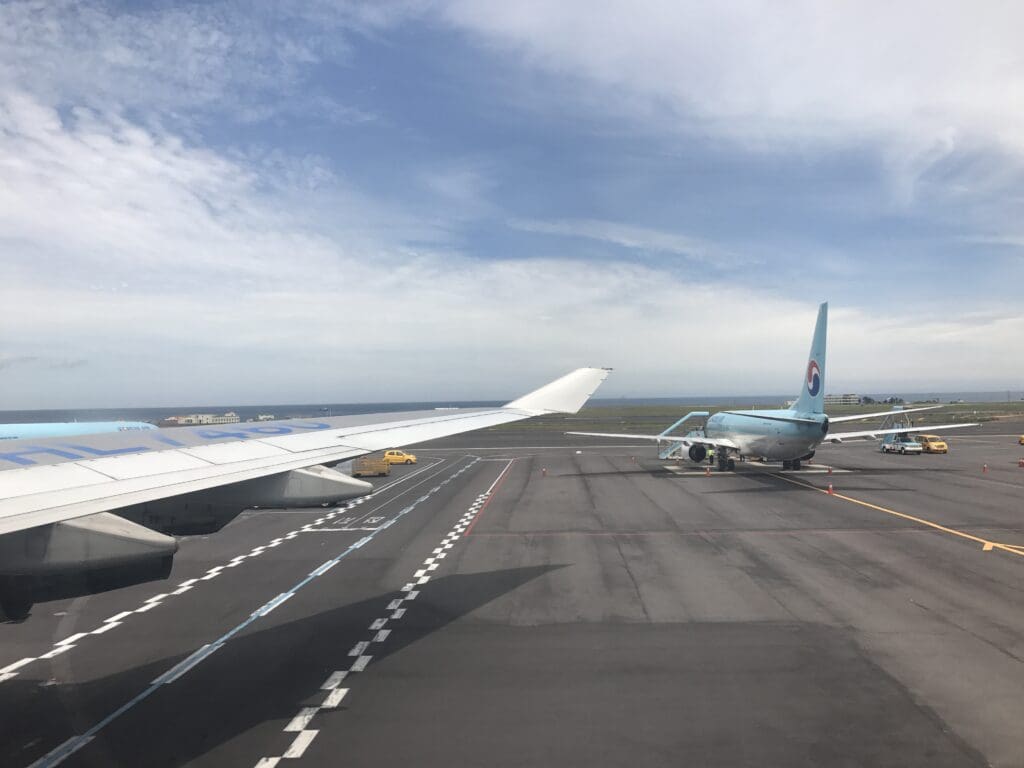
Once the tug had been disconnected, the Boeing began its taxi to the end of Runway 07. During this journey, I was treated to good views of a smorgasbord of aircraft arriving and departing, ranging in size from Airbus A320s and Boeing 737s, up to Airbus A330-300s. Within a few minutes, the Boeing reached the end of the runway where we held for a few minutes to allow for two Boeing 737-800s, one operated by Jin Air and another by Jeju Air to touchdown after their flights from Seoul Gimpo and Busan respectively. At 1135, the Jumbo Jet cautiously taxied onto the runway and came to a halt. Following a few moments, the four engines nosily spooled up and we went flying down the runway before lifting up into the Jeju skies in what seemed like a matter of seconds.






Once up in the air, the Boeing soared past the terminal building, allowing a good view of the aircraft waiting there in between flights, followed by the military complex before the aircraft soared over the perimeter fence and left the airport behind. Moments later, good vistas of Jeju City were offered whilst the cloud-covered slopes of Mount Halla could be seen in the distance. Unfortunately, parting views of Jeju were not to last for too long and we soon turned onto a northerly heading and began to cross the narrow stretch of sea that separates the island from the province of South Jeolla on the Korean mainland.





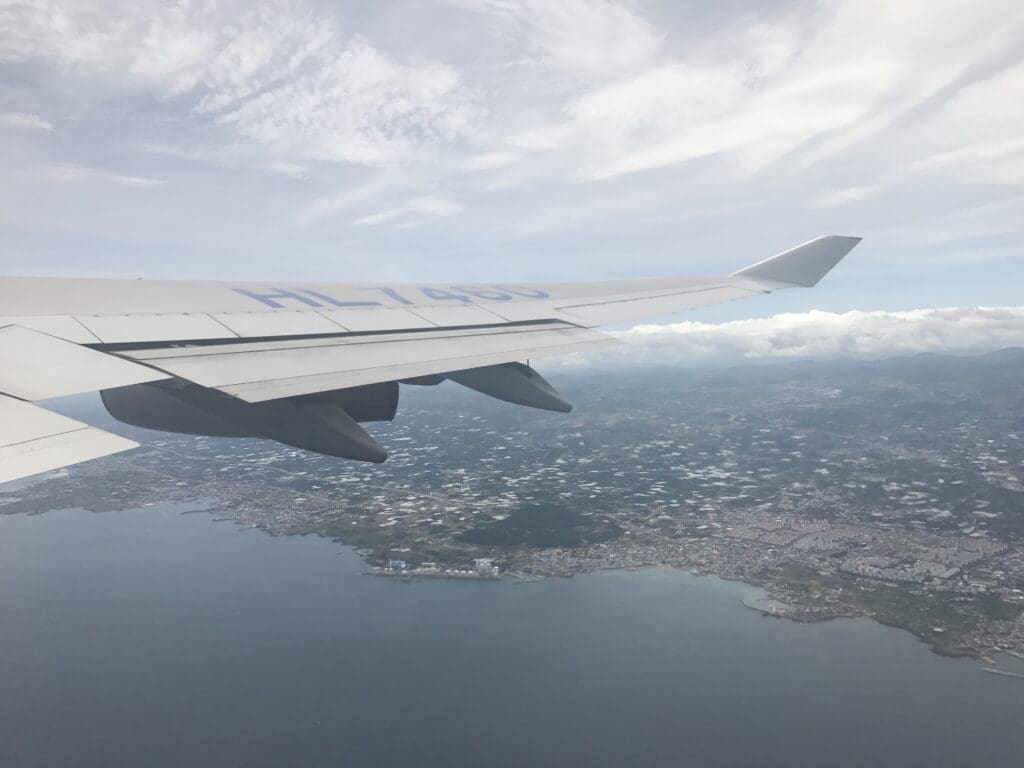





At 1139, four minutes after our departure, the seat belt signs were extinguished and below, the partially clear skies meant that during the climb, several islands could be seen below. The first to pop up was the small and remote Yeoseo Island, located almost halfway between Jeju and the mainland and home to around 100 people. A few minutes later we flew over the slightly larger Geomun Island which is located around a two-and-a-half-hour ferry ride away from the mainland. The island is famous for the Port Hamilton incident between 1885 and 1887 when, anger at agreements between Korea and Russia, and fear of a conflict with the latter, resulted in British naval forces occupying the island. This occupation ended two years later when Russia promised not to occupy any part of the Korean Peninsula. Today the island has a population of around 700 people, many of whom rely on the fishing industry to make a living. Unfortunately, as we reached the mainland the skies clouded giving us no views of the Korean Peninsula until we neared Seoul.



Whilst Korean Air may be known for their bibimbap and metal cutlery, sadly, such luxuries cannot be found on their domestic flights, with service on these limited to nothing more than a round of drinks. Once in the skies of South Jeolla, the crew took to the aisles and worked hard to ensure that all passengers would be served during the short flight. That morning, the choices consisted of the usual options of cold barley tea, hot coffee, orange juice, tangerine juice, tomato juice and water. Upon reaching my row, the very polite and friendly flight attendant offered me a drink and I decided on a Jeju tangerine juice. This was poured into a paper cup before being cautiously passed over to me with a Korean Air-Pyeongchang 2018 branded serviette.

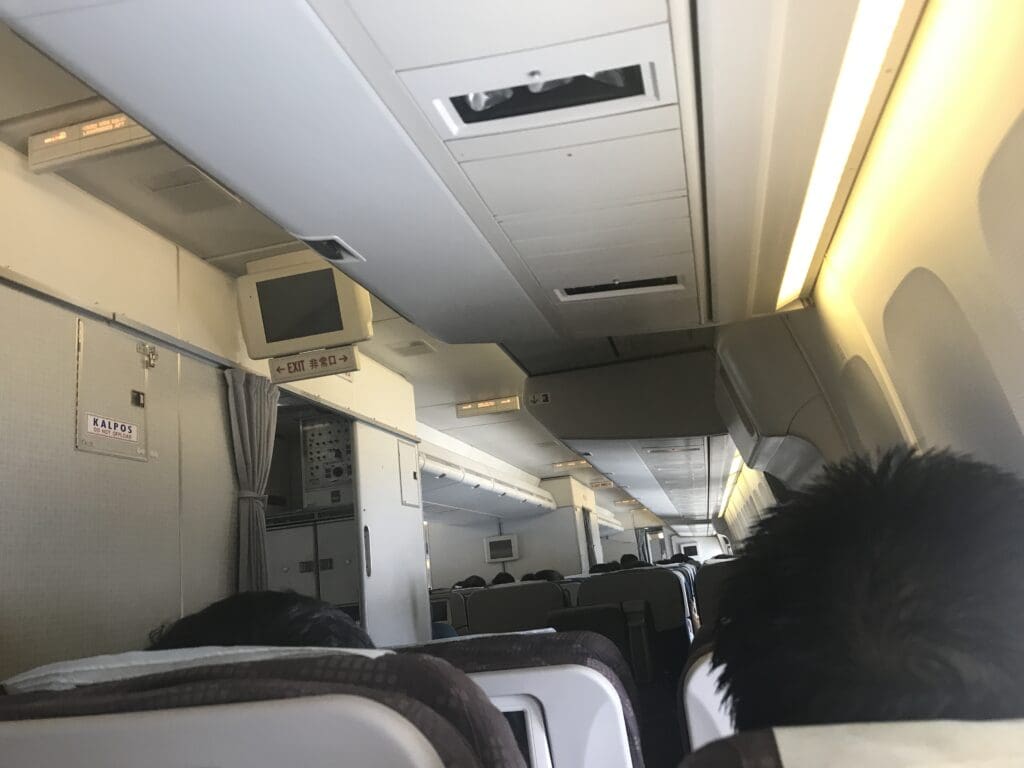
As I sipped my juice, the aircraft levelled off at 23,000 feet and we began to bounce around a little as we made our way northwards. During this time, the Captain performed their speech in Korean and English, thanking passengers for flying with Korean Air, before moving on to detail the remaining flight time and the weather on the ground in Seoul. When it came to entertainment, no headphones were offered and the inflight entertainment screens remained locked for the entire flight. Thus, the only form of inflight entertainment came in the form of the monthly Morning Calm magazine. Fortunately, this is a fairly decent publication, filled with an array of interesting articles, many of which relate to Korean Air’s domestic and international destinations. Furthermore, this does not seem to be as heavily laden with advertisements as many other inflight publications.


Fifteen minutes after the Captain had undertaken their speech, the Purser could be heard once more as they advised passengers of our impending descent, giving the usual instructions regarding seatbacks, tray tables, window shades and seatbelts. Below, a gap in the clouds temporarily revealed the grey rain-soaked landscape somewhere near the city of Anseong in the southern portion of Gyeonggi Province. When flying into Seoul Gimpo Airport, I always pick a seat on the right-hand side of the aircraft. In good weather conditions and when landing into the northwest on either Runway 32L or 32R, this ensures great views of Seoul and the surrounding area. However that day, not only were low clouds lingering around Seoul, meaning that very little could be seen until the very final stages of the flight, the wind was blowing in from the east and we would thus be landing on Runway 14R.


As we sunk lower into the grey skies the speed brakes and flaps were deployed, slowing us from 240 knots to 180 knots in the space of a couple of minutes as we flew above northern Incheon. We then made a wide 180-degree turn to line us up for Runway 14R, during which time the aircraft flew parallel with the Han River. Eventually, the Boeing broke free of the thick grey clouds and the landscape of apartment blocks and green hills appeared as we neared the airport. As we edged closer towards the airport, these transformed into industrial estates and farms before we floated down over the Ara Canal and passed over the perimeter fence.







At 1223, just 48 minutes after taking to the skies, the Boeing made a gentle touchdown on Runway 14R before the roar of the engines could be heard as the reverse thrust was applied. Looking outside, the interesting smorgasbord of helicopters and light aircraft could be seen whizzing past and we seemed to travel the full length of the runway before vacating this to the left and commencing our short journey to the domestic terminal.






From the runway, the Boeing crossed over the parallel runway and journeyed past Korean Air’s large maintenance facility where three Boeing 747-400 Freighters could be seen waiting to head off for a new life in the United States, alongside a long-retired Airbus A300 that would never take to the skies again. That lunchtime, the Boeing would end its journey at Stand 4. This would mean a relatively short taxi was in order and at 1230, the Boeing cautiously pulled into the gate and came to a halt, with an Eastar Jet Boeing 737-800 that had taken off from Jeju just after us pulling into the neighbouring gate a minute later.

That afternoon, it seemed as if many passengers were in a rush to exit the aircraft. Fortunately, for those in a hurry, it took no more than a couple of minutes for the jetbridge to be connected to the aircraft and once this was in place, disembarkation commenced. Once the queue of passengers in the aisle began to shift, I stood up and made my way through the cabin, thanking the crew members that I passed along the way before reaching the front of the aircraft where I stepped off and headed up into the terminal building. From the gate, a fairly long walk was in store to reach the baggage carousels, although, with nothing to pick up, I was able to speed through this hall and made my way out into the landside arrivals area before beginning the journey to the airport station.


Summary
From an aviation enthusiast’s standpoint, my experience was fantastic – this enabled me to fly a Boeing 747 easily and cheaply without the need to trek to the other side of the world. Meanwhile, my onboard experience was also very good and I found the cabin to be clean, comfortable and in great condition, whilst the crew were polite and friendly and the complimentary drinks were appreciated. Thus, with all considered, I was left with nothing but praise for Korean Air following this experience.



